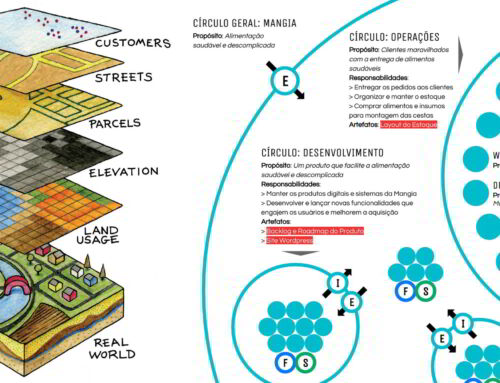If your organization is shifting into self-management, you may find yourself going through a transition from manager to systems thinker. The most common path (though not without its pitfalls) is for you to become an External Link (Organic Organization) or Lead Link (Holacracy) of one or more circles. In this text we will cover the similarities, differences and main mistakes made on this journey.
The Role
To begin with, let’s look at the O2 Meta-Agreements, description of the External Link role.
Purpose: The purpose of the Circle
accountabilities:
- Structuring the Circle to express your Purpose
- Assigning people to Roles in the Circle; monitoring suitability; providing feedback to improve suitability; and re-assigning Roles to others when necessary
- Setting priorities for the Circle
Artifacts:
- Assigning Roles within the Circle
STRUCTURING THE CIRCLE
Let’s start with the purpose. The External Link serves exactly the same purpose as the purpose of the circle. The intention behind this is for the External Link to act as a membrane capable of holding all the things that are part of the circle but not assigned to any role in the circle. That is, if there is a request that makes sense for the circle, but which has no responsible role, the External Link can deal with it, while also paying attention to the accountability which states “Structure the Circle to express your Purpose”. If there are recurring demands that the External Link is taking on, it should structure the circle to accommodate those. In other words, adapt the organizational structure.
That means a good External Link won’t be too much trouble. Every time a novelty appears, he must structure the circle to accommodate that new activity, whether proposing a role, modifying an existing one, or even creating a new inner circle. This accountability ends up being exercised especially when the outer circle proposes a change in the inner circle. Here’s an example:
Imagine that you fill the External Link role in the Operations circle of a company called Mangia. This circle has the following attributes:
Purpose: Customers delighted with the delivery of goods
accountabilities:
- Delivering orders to customers
- Organizing and maintaining inventory
Artifacts: Inventory Layout
Let’s suppose that a tension is processed in the outer circle (which you are a member of as the External Link of Operations) in which the following accountability is added to the circle:
Buy food and supplies to assemble the baskets
That is, Operations needs to perform a new activity for which there is no defined role as of yet. As External Link, what are some of the ways you can deal with this?
- Buy food and supplies next week yourself, after all, you are the External Operations Link;
- Propose a new role within Operations that will perform this activity. This role can be assigned to yourself or someone else;
Both paths are possible. Path a) works if there’s a sense of urgency and not enough time for the second. Path b) however, is more suitable as it gives more clarity to the structure of the circle and avoids implicit accountabilities.
That’s why we say that the External Link role shouldn’t occupy more than 20% of a person’s time. A good External Link will “clear out” the role as new things emerge.
Assigning people to roles
The External Link is also accountable for “Assigning people to the Roles within the Circle; monitoring suitability; providing feedback to improve suitability; and reassigning Roles to others when necessary”. This means that the External Link must look for good people within the organization to perform each of the roles within the circle. But that doesn’t mean:
- The External Link is accountable for one’s career, development and/ or promotion;
- The External Link should provide feedback on “behavior”;
- The External Link must mediate conflicts between the members of the circle (much less the Facilitator);
Let’s be clear. The role of the External Link is different from that of a conventional manager. The External Link should only be concerned with the person-role fit in that circle, nothing more. If someone is not filling the role at least adequately, then he (and only the External Link, as there is an Artifact defined) can remove the person from the role. What happens to the person after that is another story.
When an organization is transitioning to self-management, it is common that issues related to career and people development have not yet been addressed. In this case, if someone comes to the External Link, believing that the External Link should resolve such an issue, then, instead of continuing to act as a former manager, it is best to encourage that person to bring this tension into the circle. So that whoever feels the tension also becomes a protagonist in solving the problem, instead of off loading it on to the External Link.
Setting priorities
The External Link’s ultimate accountability is to “Set priorities for the Circle.” Note that priorities are for the circle, not individuals. A good External Link sets general guidelines of what is most important to the circle, rather than giving orders and to-do lists. For example, as Mangia’s Operations circle External Link you might define the following heuristic to help with prioritization:
Quality and healthy foods even over low-cost foods
This orientation gives clarity on a possible choice between two polarities that different roles in the circle have to make. Rather than setting deadlines, it is more useful to specify priorities in the form of choices or trade-offs. OKRs can also help provide clarity on what matters most.
The main pitfall here is not getting into individual prioritization. If any member of the circle asks for your help in understanding what is most important, offer your opinion without worry. But act more reactively than proactively in this regard, to allow individuals some space to set their own priorities.
MAIN PITFALLS
Now that we’ve clarified the role of the External Link, let’s look at some of the main pitfalls you might be tempted to fall into.
Feeling like the owner or leader of the team. The people who are part of the circle, in which you are the External Link, are not your team. Remember the issue of power over the other, which we addressed in the text on collaboration. As the External Link, you are just another person filling a role with some accountabilities.
Acting as a communication’s filter. People will come to you to ask for circle-related things, as no one knows the entire organizational structure and roles of a company. In this case, you must guide the person:
What you’re asking me is actually the accountability of the Contracting role, which Iris now fills. Feel free to take up that request directly with her.
Next time, that same person will know that Iris is accountable for this and will go straight to her. Or the person will consult the organizational structure described on the platform (holaSpirit, GlassFrog), whichever one works better.
Failing to de-energize someone who is not doing a good job. When someone is not putting their waking energy into a role, you must guide that person by providing constant feedback. If that doesn’t work and the work remains unsatisfactory, just remove the person from the role. This is good feedback. There is usually a circle that helps people find new roles within the organization, or leave the company if that is not possible.
CHANGING THE EXTERNAL LINK ROLE
Meta-Agreements allow you to change the role of the External Link. Take a look below:
The Core Roles of each Circle can be changed during Adapt Mode. However, the following restrictions apply:
- The Purpose of Essential Roles cannot be changed;
- New accountabilities and Artifacts cannot be added to the External Link Role;
- Initial External Link Role accountabilities and Artifacts may be modified or removed entirely, provided they are delegated to another Role or process in the Circle;
- The initial accountabilities and Artifacts of the Facilitator, Secretary and Internal Link Roles cannot be removed or modified.
That is, anyone can propose to remove External Link accountabilities and artifacts from a specific circle, provided they are delegated or assigned to another role or process.
The purpose of this rule is to make room for experimentation. For example, you could create a self-allocation process, where anyone can assign themselves to a role as long as they clarify the motive and tension. That’s what we do at Target Teal.
Still, we recommend using this feature very carefully! Remember that any change in the organizational structure must start with a tension.
Conclusion
We hope that this text has clarified what we understand as an evolution from the position of manager to the role of External Link within the social technology Organic Organization. Any clarifying questions or reactions? Comment below! :)
¹In this text we establish a basis for comparison with the role of the External Link, from the social technology Organic Organization, v2.1. The Lead Link, is a similar role present in Holacracy. The only notable difference between these two roles is that Holacracy has more explicit accountabilities, such as allocating resources and defining metrics.
Translated by Tanya Stergiou






Leave A Comment